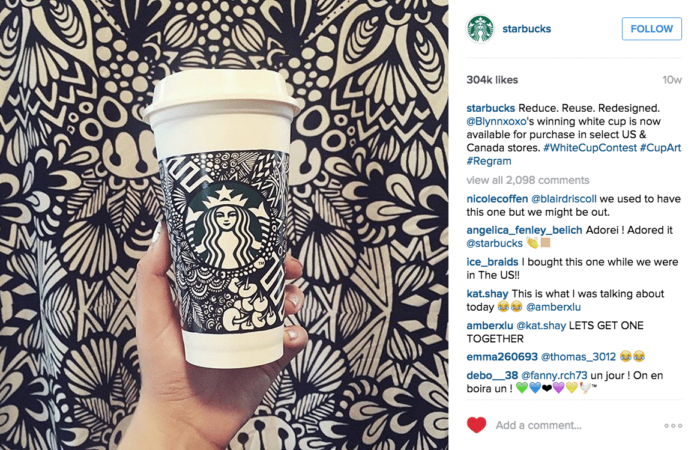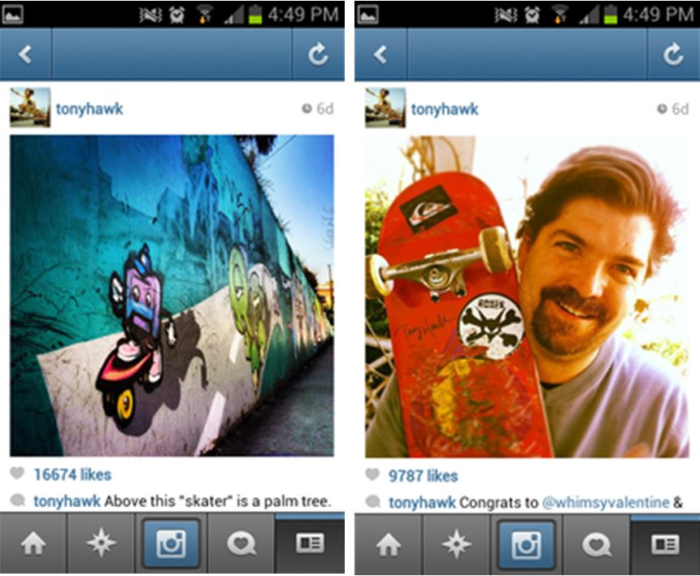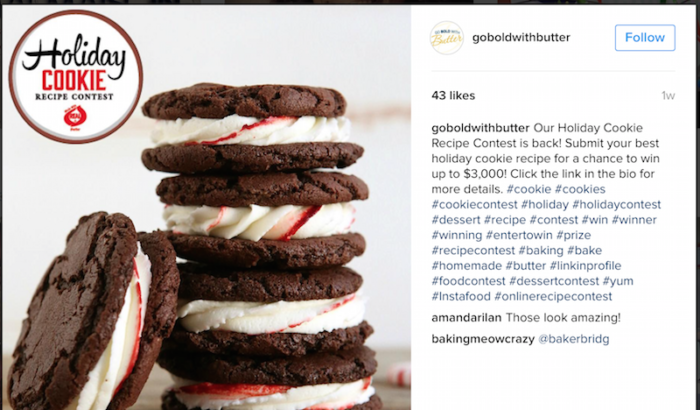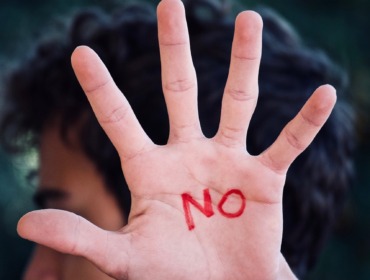Make your Instagram Contest a success! Tips for competitions on Instagram.
Instagram is massive. With 800 million monthly users and 500 million daily users, it commands massive market potential and has for a long time been a powerhouse in the social media world, and doesn’t plan on slowing down. With ad-plans becoming more competitive, and Influencer Marketing proving to be the new social business, Instagram is one of the best places to promote your product.
Instagram scores above the rest with their high user interaction rate and therefore offers a great platform for contest opportunities that the users can interact with. Nevertheless, there are a few things to keep in mind when planning a competition on the platform. We have collected tips that you should consider before, during, and after the contest, which we will share with the examples below.
Before the contest:
Set goals
The objective is, as with any measure, an important indicator for the whole campaign. Even for an Instagram contest, the question of “What is the desired outcome?” must be asked. The answer sets in place the budget, the analysis, the choice of contest, and more: in short, without a goal, there is no strategy.
Define the target group
To whom is the post directed? True to the motto “Target your market”, who should see your campaign? For a clear and defined target group, it is often helpful to find certain preferences and inclinations that influence the choice of contest type and other areas.
Determine an attractive prize
As with any kind of social media post, there are viral contests, which users take part in ‘just for fun’. However, in most cases introducing an attractive prize attracts greater interest and generates more attention. In addition, the nature of a competition also influences the prize: a video contest should have a higher price than a hashtag contest, for example. However, the connection to your brand is not an insignificant issue, which leads to the next point…
Determine a theme
A reference to the brand and/or the prize is crucial here. Since contest-related topics limit the number of participants and focus the activities, this should be chosen sensibly.
Determine the type of contest
The questions that should be asked here are: Are your goals best achieved by use of a video or a photo contest? Does the target market interact especially with hashtag competitions, or are they better engaged by a trademark-free approach? Specific examples follow below.
Determine a timeframe
How long should the competition run for? Is there sufficient time to create the promotion you want? How fast are the customer reactions on average and how much wiggle room needs to be planned?
Define the rules and conditions of participation
Regarding the legal terms of use, a contest on Instagram must also adhere to and comply with the rules of participation. Among other things, it should be noted here who can participate in the contest.
Start and manage the contest
The easiest type of contest to use and manage is a Hashtag or Hashtag-Combination competition, due to the ability to look up and find various entries through the use of one well-chosen hashtag. To help with evaluating your contest, a tool is often very useful, such as http://corp.wishpond.com/instagram-contest-app/.
The Contest
The user should be able to see at a glance what the consequence/goal of their action is. To this end, the title of the campaign, the conditions of participation, the task to be performed, the company, and the potential gain should all therefore be clearly communicated in the image and/or comment field. Our tip: keep the text short, generate attention with eye-catching visual material and meaningful hashtags, and use CTA’s (see example)


Following the instagram contest guide of hubspot, to generate attention and engagement, a question can be asked, or the customer can be addressed directly. In order to keep the threshold at which the customer feels unmotivated to partake in the contest as low as possible, the customer sometimes has to be taken by the hand and pointed in the right direction. This is done with short and crisp, as well as step by step pointers with plenty of prompts (see example).

A campaign-specific hashtag fulfils many criteria. The use of a branded hashtag helps the company achieve greater reach and increase branding effects. However, it is not always necessary to use a brand hashtag. The selection of a hashtag should always be both individual and appropriate to the campaign. On the other hand, a hashtag primarily allows for easy monitoring and evaluation of the campaign (see example).

Important: Instagram competitions must include terms and conditions. The rules must therefore be transparently communicated. Who can join? How are the winners chosen? How is the user-generated content handled, and will it be eventually used for future marketing campaigns? This information can be placed either in the picture itself or in the comment field. This can be achieved, for example, by referring to the profile link and placing the conditions of participation on an extra landing page on your website (see example).
The contest type should correspond to the goals of the campaign. The simple ‘Like’ is easier for the user to complete than, for example, the posting of a picture, and hence it is less of a hurdle for the user to overcome. However, it must be noted that by increasing the simplicity of the contest, there are consequently a larger number of users that are not really interested in the product, but interested predominantly in profit. Actions for which users need to create user-generated content create a much closer audience-specific interaction. The possibilities are diverse, but here are some common examples:
Like-to-win contest
As it reads: If you like the post, you’re in the draw.
User generated content

The user is tasked with creating a competition-specific post. They have to post a video or photo, along with a corresponding hashtag. Ideally, the created content can be reused by the business. It gives the user the feeling they can contribute to the product or service, to expand or improve it. In this case, there are no limits to your creativity. The user can, for example, create recipes or objects that carry their own stamp or personal artistic expression, making for unique and personal posts that further connect yourself and the user.

You can find more good examples from Instagram profiles of companies such as Starbucks (https://www.instagram.com/starbucks/) and Lush (https://www.instagram.com/lush/)
In your competition, why not take advantage of the environment in which the target group is always located? The “Hidden products” contest, based on the theme of the Easter egg search, works particularly well. The user needs to hide a brand-specific product and post a picture of it. For some products, this funny kind of contest can work quite well, for example:
Source: Screenshot
Use holidays and special dates

Holidays are a great way to interact with your customers on an emotional basis. On Halloween, for example, the user could dress up the product spookily. Holidays are always around the corner, and users are usually the most active to contests and competitions at this time.

Father’s or Mother’s Day also offers a good opportunity for emotional interaction (see example).
Online-offline linking
Especially for physical stores, there are contests that involve a connection between the online contest and the offline store. The possibilities are endless, for example one part of the contest can be that the customer needs to appear disguised in one of the shops.
Using Instagram solely as a promotion tool
It is not required, of course, that the contest is wholly run from Instagram. There is also the possibility of setting the competition up on your website and using Instagram as a promotional path to your website. For sites with their own web shop, this is a particularly interesting way to spread their own action, to encourage users to interact further with your website.
Instagram Story Competition
Another approach to organize a competition via Instagram is to use Instagram stories. Users can participate by answering to your story in a direct message. You could ask a question they have to answer or let them describe their favourite product from your brand. Furthermore, you could start a survey and pick the winner of the contest from the right answers. The story could also feature a hidden object game, in which the participants have to find and highlight a certain object and send you the screenshot. The more creative, the better. You may want to send a short text to all participants, saying thanks for entering the contest and reminding them about when the winner will be drawn.
Story contests allow to tell a short story by using several pictures and videos. You can build tension and suspense to increase the desire to participate in your competition. Another advantage lies in the protection of the user-privacy: Not everyone wants to comment on pictures. Furthermore, the time limit of an Instagram story adds an exclusive touch to your competition. It is very likely for you to attract actual followers, who actively watch your stories. This aspect is also one of the main disadvantages of story competitions. Only you as the organiser of the competition will be able to see the answers and reactions. Therefore, you will attract less attention to your Instagram story competition.
Promote the contest
Wide promotion in social networks
What is the use of a creative action that has been tediously conceived if it is poorly distributed to the target group? For this reason, it is a good idea to not only use Instagram for distributing your contest, but also to use other social media platforms on which the company is active. In order to build up sufficient reach, it is imperative to use additional media budget to give your campaign the push it needs.
Announcements using your own web presence
In addition, users can be made aware of the campaign through email, blog posts or website tips. In this case as well, the connection between online and offline measures must be taken into account. It can be integrated into the store using digital displays or interactive print media.
After the contest
Determine and inform winners
It is important to notify not only the winners themselves, but all the participants, at the end of the contest. After the drawing of winners, whether it be by the company, a user vote or by a third party, it always makes sense to congratulate and thank all participants and make sure the end of action is clear to existing and potential participants. The other participants do not always have to leave empty handed, even if no benefit was originally announced. Using subsequent discount campaigns or similar techniques keep your contest as a positive memory for the participants, and has the additional benefit of maintaining contact with your users. A reference to future contests also arouses the interest of users, and keeps them connected to your media channels.
Promote the winning photo
The winner should, of course, also get some glory. The participants have all gone through a lot to complete a certain task, after all. In addition, and as importantly, customer loyalty can be strengthened. This not only encourages the winner, but often also their community (friends & acquaintances), to further use and promote the product. It is therefore advisable to promote the winning image on other social networks and your own website.




